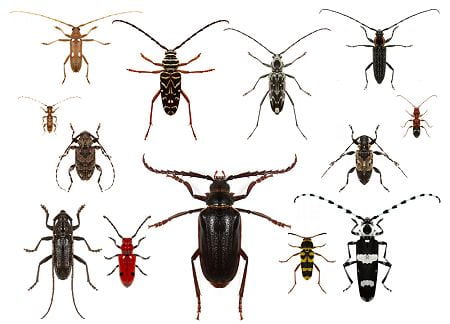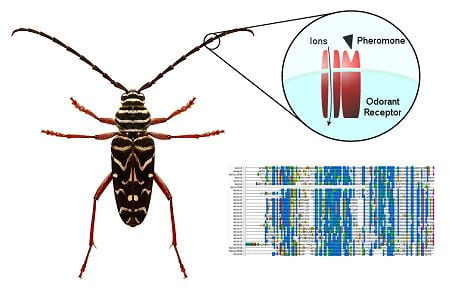Research in the Mitchell Lab
The Mitchell lab explores the field of chemical ecology, a broad discipline that addresses how organisms produce and use chemical signals to exchange information, locate food and mates, and generally navigate their environment. Our primary focus is the chemical ecology of insects, many species of which rely heavily on olfaction (smell) and gustation (taste) as sensory inputs. Research in chemical ecology is therefore critical to understanding how insects interact with each other and their environment, and how we might manage species that are pests.
Our research is guided by two major questions:
- How do organisms perceive and evaluate chemical signals?
- What drives the evolution of chemosensory systems?
We address these through several lines of research, including the ecology and behavior of insects in the field and the chemoreceptors that detect chemicals at the molecular level. Current lines of research primarily involve the Coleoptera (beetles) and especially the beetle family Cerambycidae (longhorned beetles), which are excellent models for olfactory biology because of their strong reliance on chemical signals for mating and oviposition.
Chemical Ecology of Longhorned Beetles

The longhorned beetles are among the most diverse and spectacular groups of insects. The trademark antennae are often longer than the body, and the large, colorful adults are an important aesthetic contribution to any insect collection. Though larvae of most species in this family feed in the wood of recently dead or decaying trees, others feed in living trees and can be terribly destructive forest pests. Thus, chemical signals and cues used by the beetles are of critical importance, as they can become powerful tools for monitoring pests and manipulating their behavior.
Pheromones – chemical signals used for communication within a species – play a prominent role in cerambycid ecology. Males of many species produce long-range pheromones that aggregate both sexes, and females of a few species produce pheromones that are only attractive to males. In either case, these pheromones are strongly conserved, meaning that a few types of pheromone are produced by many species, even when these species overlap both geographically and seasonally. This is interesting from an ecological standpoint (how can they tell one species from another?), and also hints at a broad-spectrum method for controlling species of pests.
This research is conducted in close collaboration with the Hanks Lab at the University of Illinois and the Millar Lab at UC-Riverside, with the goal of describing pheromones and attractants used by native and invasive cerambycid species. We have tested the efficacy of these chemicals in field trials across the country in order to develop broad-spectrum lures to be used in monitoring programs and studied how co-occurring species preserve mating isolation despite sharing pheromone components. Most recently, we have been collaborating with the McKenna Lab at the University of Memphis to develop a comprehensive phylogeny of the Cerambycidae that is informed by pheromone biology and chemosensory genomics (see below).
Representative Publications
- Rice, ME, LM Hanks, S Halloran, JA Mongold-Diers, AC Grommes, RF Mitchell, AM Ray, and JG Millar. 2022. Methionol, a sulfur-containing pheromone component from the cerambycid beetle Knulliana cincta cincta. J. Chem. Ecol. 48: 347-358.
- Hanks, LM, JA Mongold-Diers, RF Mitchell, Y Zou, JCH Wong, LR Meier, TD Johnson, and JG Millar. 2019. The role of minor pheromone components in segregating 14 species of longhorned beetles (Coleoptera: Cerambycidae) of the subfamily Cerambycinae. J. Econ. Entomol. 112: 2236-2252.
- Mitchell, RF, AM Ray, LM Hanks, and JG Millar. 2018. The common natural products (S)-a-terpineol and (E)-2-hexenol are important pheromone components of Megacyllene antennata (Coleoptera: Cerambycidae). Environ. Entomol. 47:1547-1552.
- Mitchell, RF, PF Reagel, JCH Wong, LR Meier, WD Silva, J Mongold-Diers, JG Millar, and LM Hanks. 2015. Cerambycid beetle species with similar pheromones are segregated by phenology and minor pheromone components. J. Chem. Ecol. 41: 431-440.
Chemosensory Genomics of Beetles

Chemosensory genomics explores the genes that underlie smell and taste, which evolve rapidly and can often only be identified from genome-scale sequencing. Projects in the lab involve many gene families, but especially the odorant receptors (“ORs”), which are among the largest gene families in insects and one of the primary mechanisms used to detect volatile chemicals. The family is unique to insects and distinct from the analogous receptors found in vertebrates, but they are part of a neural architecture in the brain that is surprisingly similar. As the most basic unit of insect olfaction, ORs are thus a first step in understanding the repertoire of chemicals that can affect insect behavior. Once isolated, ORs can be assayed against panels of chemicals to find new attractants (“reverse chemical ecology”), developed into genetic markers for olfactory sensitivity, and reveal evolutionary histories.
The ORs of cerambycids – and of the Coleoptera as a whole – remain almost completely unexplored. Research in the lab is increasingly focused on annotating ORs of diverse beetle species in order to explore potential clades of pheromone receptors, identify other conserved receptor groups, and map the evolution of chemosensory genes across the many superfamilies of beetles.
Our early functional work led to the first functionally characterized beetle ORs from the cerambycid Megacyllene caryae. Three of these receptors were sensitive to pheromones, providing initial steps toward understanding molecular pheromone reception in the Cerambycidae and the Coleoptera. Subsequent research has explored the ORs of many species across the Coleoptera, drawing from public genomes as well as many collaborations with other research groups to create a comprehensive phylogeny of coleopteran ORs.
Representative Publications
- Mitchell, RF, D Doucet, S Bowman, MC Bouwer, and JD Allison. 2022. Prediction of a conserved pheromone receptor lineage from antennal transcriptomes of the pine sawyer genus Monochamus (Coleoptera: Cerambycidae). J. Comp. Physiol. A 208: 615-625.
- Mitchell, RF, and MN Andersson. 2021. Olfactory Genomics of the Coleoptera. In: Blomquist, G, and R Vogt (eds), Insect Pheromone Biochemistry and Molecular Biology, 2nd Ed. Academic Press, Cambridge, MA, USA, pp. 547-590.
- Mitchell, RF, TM Schneider, AM Schwartz, MN Andersson, and DD McKenna. 2020. The diversity and evolution of odorant receptors in beetles (Coleoptera). Insect Mol. Biol. 29: 77-91.
- Andersson, MN, CI Keeling, and RF Mitchell. 2019. Genomic content of chemosensory genes correlates with host range in wood-boring beetles (Dendroctonus ponderosae, Agrilus planipennis, and Anoplophora glabripennis). BMC Genomics 20:690.
- Mitchell, RF, DT Hughes, CW Luetje, JG Millar, F Soriano-Agatón, LM Hanks, and HM Robertson. 2012. Sequencing and characterizing odorant receptors of the cerambycid beetle Megacyllene caryae. Insect Biochem. Mol. Biol. 42: 499-505.